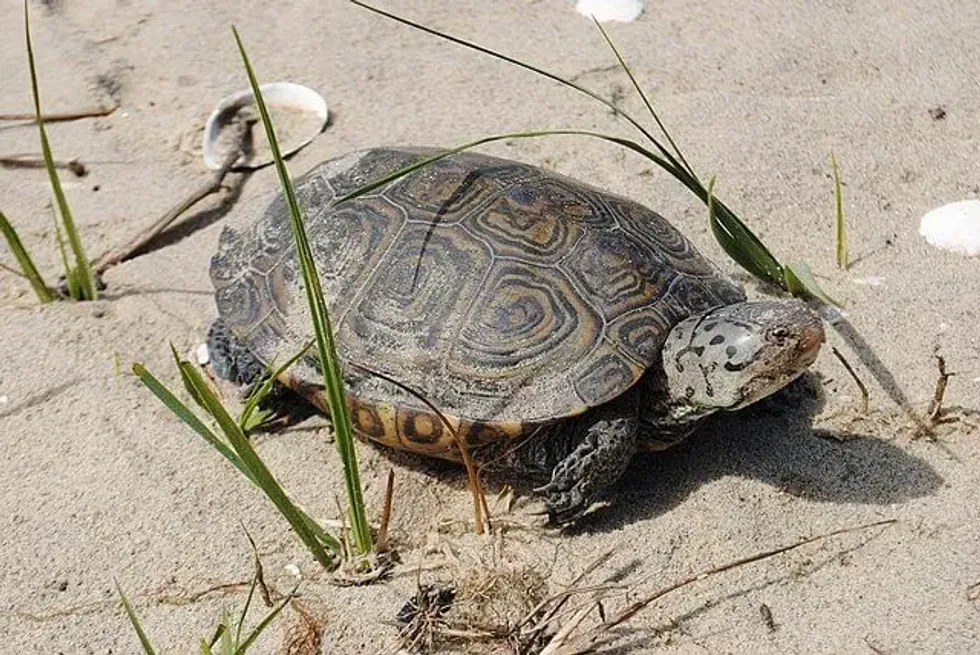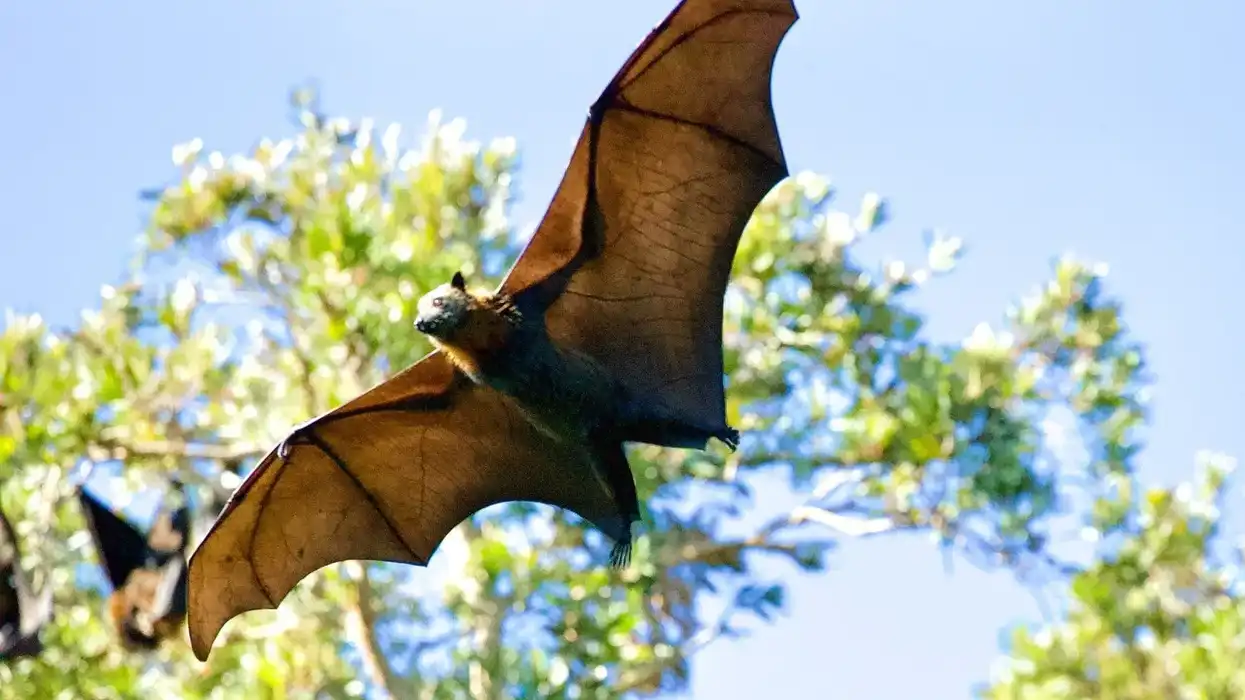A riverine turtle species, the northern river terrapin (Batagur baska) is endemic to southeast Asia. The species is one of Asia's largest freshwater and brackish water turtles.
In Bangladesh, the species is found in Sundarbans, while its wider geographical range also includes Cambodia, Indonesia, Malaysia, West Bengal, and Orrisa of India. The species has become regionally extinct in parts of Myanmar, Thailand, Singapore, and Vietnam.
The shell of the turtle is generally depressed, and the plastron is big and strongly angulated in juveniles, while convex in adults. The northern river terrapin has band-like scales on its legs, while its head is quite small.
It also possesses an upwards-facing pointed snout. The upper surface of the shell or carapace is generally soft and olive-green in color, whereas the plastron is yellow.
The neck and head are generally brown and have a red base. Unlike females, breeding males have a black neck and head, while their forelegs turn orange.
The pupils are brown and yellowish-white in females and males, respectively. The average weight and length of these turtles are around 38-40 lb (17-18 kg) and 23-23.6 in (58-60 cm), respectively.
The species has been listed as Critically Endangered by the International Union for Conservation of Nature (IUCN) due to a loss of nesting beaches, pollution, and hunting. Several organizations such as the Turtle Survival Alliance (TSA), the Forest Department of Bangladesh, and the Prokriti O Jibon Foundation are working towards improving the status of the species.
Keep on reading to learn more interesting facts about the northern river terrapin. If you want to know more exciting information about different animals, check out the olive ridley sea turtle and the softshell turtle here on Kidadl.
Northern River Terrapin Interesting Facts
What type of animal is a northern river terrapin?
The northern river terrapin (Batagur baska) is one of Asia's largest freshwater and brackish water turtles. In Bangladesh, the species is found in Sundarbans, while its wider geographical range also includes Cambodia, Indonesia, Malaysia, and West Bengal, and Orrisa of India. The species has become regionally extinct in parts of Myanmar, Thailand, Singapore, and Vietnam.
What class of animal does a northern river terrapin belong to?
The northern river terrapin (Batagur baska) belongs to the class of Reptilia, the family of Geoemydidae, and the Batagur genus. Species such as southern river terrapins and painted terrapins also belong to the Batagur genus.
How many northern river terrapins are there in the world?
Studies reveal that the population of the Batagur baska species may be less than 100. The population is largely affected by hunting and a loss of habitat, and the species is also listed as Critically Endangered in the IUCN Red List.
Where does a northern river terrapin live?
The Batagur baska species is native to southeast Asia, while in Bangladesh, the species is found in the Sundarbans. The species' geographical range also includes Cambodia, Indonesia, Malaysia, West Bengal, and Orrisa of India. The species has become regionally extinct in parts of Myanmar, Thailand, Singapore, and Vietnam.
What is a northern river terrapin's habitat?
The typical northern river terrapin habitat generally includes tidal areas of estuaries, large rivers, and mangrove forests. These turtles generally spend most of their time in brackish or freshwater and generally come on land in the breeding season to make nesting sites and lay eggs.
Who do northern river terrapins live with?
Generally, terrapins are solitary and prefer to live alone, but northern river terrapins (Batagur baska) are social creatures who are seen basking together with other terrapins. Also, during the breeding season, males and females of the species come together in their habitat.
How long does a northern river terrapin live?
The average lifespan of northern river terrapins (Batagur baska) is around 25 years, while turtles generally live for around 40-80 years. It is also said that the life expectancy of this species generally increases if kept in captivity and provided with a healthy diet.
How do they reproduce?
The breeding season of northern river terrapins (Batagur baska) generally occurs between December and March, and these turtles generally move from freshwater habitats to brackish water during the breeding months. Male turtles generally compete with other males to mate with a female. Also, several courtship displays such as head swaying and throat pumping are performed to attract females.
These animals also use the land to make nesting sites, and the female lays around 10-34 eggs in each clutch. It takes around 70-80 days to hatch eggs and it also depends on the temperature and the size of the nest.
What is their conservation status?
Northern river terrapins (Batagur baska) have been given a conservation status of Critically Endangered by the International Union for Conservation of Nature (IUCN). Threats such as pollution, a loss of nesting beaches, and hunting have deeply affected the population of the species and have resulted in this worrying conservation status.
Several organizations such as the Turtle Survival Alliance, the Forest Department of Bangladesh, and the Prokriti O Jibon Foundation are working towards improving the status of the species. Also, initiatives such as captive breeding programs have been introduced in Bangladesh and India to increase the population of the species.
These programs have shown positive results, and the population is increasing as well. Such initiatives aim to bring the species away from the brink of extinction and, hopefully, change its conservation status for the better.
Northern River Terrapin Fun Facts
What do northern river terrapins look like?
The shell of this turtle is generally depressed; the plastron is big and is strongly angulated in juveniles, and convex in adults. The northern river terrapin has band-like scales on its legs, while its head is quite small. It also possesses an upwards-angled pointed snout.
The upper surface of the shell or carapace is generally soft and is olive-green in color, whereas, the plastron is yellow. The neck and head are generally brown and have a red base.
Unlike females, breeding males have a black neck and head, while their forelegs are orange. The pupils change to brown and yellowish-white in females and males, respectively. These features can help to identify the species.

*Please note that this is an image of a diamondback terrapin, not a northern river terrapin. If you have an image of a northern river terrapin, please let us know at hello@kidadl.com.
How cute are they?
These turtles are really cute, and anyone would love to see the juveniles crawl. Also, the color of the body changes in the breeding season which is really fascinating!
How do they communicate?
Like other turtles, northern river terrapins (Batagur baska) use similar methods to communicate. These animals possess several calls that are used while finding mates during the breeding season. They also fight and perform multiple courtship displays.
How big is a northern river terrapin?
The average weight and length of northern river terrapins (Batagur baska) are around 38-40 lb (17-18 kg) and 23-23.6 in (58-60 cm), respectively. These turtles are slightly bigger than snapping turtles and 10 times bigger than bog turtles.
How fast can a northern river terrapin move?
The exact speed of northern river terrapins (Batagur baska) is not known as of now, but they are active while finding their prey. Their diet also includes many small animals, showing that they have the ability to hunt with sharpness.
How much does a northern river terrapin weigh?
The average weight of these turtles is around 38-40 lb (17-18 kg).
What are their male and female names of the species?
There is no separate name for male and female turtles, they are simply commonly referred to as northern river terrapins.
What would you call a baby northern river terrapin?
No particular name is used to refer to a baby northern river terrapin.
What do they eat?
These turtles are omnivores and the average northern river terrapin diet generally includes waterside plants and small animals such as clams, crabs, and oysters.
Are they dangerous?
Very little is known about the behavior of these animals, but turtles are known for their extreme bite force and they can attack if they feel threatened.
Would they make a good pet?
No, it is not possible to keep them as pets. However, they can be found in some zoos.
Did you know...
The huge size of this species makes it unique.
In India and Bangladesh, people sometimes eat these turtles.
Is the northern river terrapin endangered?
The assigned northern river terrapin conservation status is Critically Endangered, according to the International Union for Conservation of Nature (IUCN). Threats such as pollution, a loss of nesting beaches, and hunting have deeply affected the population of the species. These animals have become regionally extinct in countries such as Singapore, Myanmar, Thailand, and Vietnam.
Several organizations such as the Turtle Survival Alliance, the Forest Department of Bangladesh, and the Prokriti O Jibon Foundation are working towards improving the status of the species. Also, initiatives such as captive breeding have been introduced in Bangladesh and India to increase the population of the species.
These programs have shown positive results. The population and its range are increasing as well, and such initiatives hope to bring the species from the brink of extinction.
How did the northern river terrapin get its name?
Since the species is a freshwater turtle, it came to be known as the northern river terrapin.
Here at Kidadl, we have carefully created lots of interesting family-friendly animal facts for everyone to discover! Learn more about some other reptiles from our hawksbill sea turtle facts and green sea turtle facts for kids.
You can even occupy yourself at home by coloring in one of our free printable Northern river terrapin coloring pages.
*Please note that this is an image of a northern diamondback terrapin, not a northern river terrapin. If you have an image of a northern river terrapin, please let us know at hello@kidadl.com.










